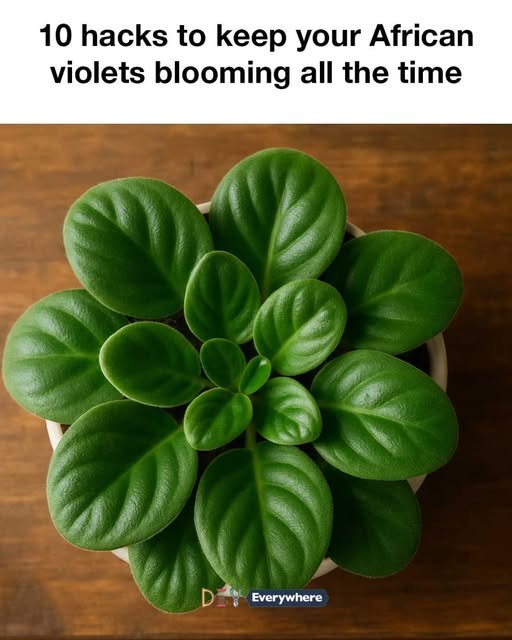African violets, known for their vibrant blooms and lush foliage, are a favorite among indoor plant enthusiasts. However, keeping them in bloom consistently can be challenging due to their specific care requirements. These delicate plants are sensitive to environmental changes, and even minor deviations in care can lead to a decline in flowering.
Understanding the common challenges, such as improper lighting, inconsistent watering, and unsuitable soil, is crucial for maintaining their health and encouraging continuous blooms.
Understanding the Importance of Proper Lighting for African Violets
African violets thrive in bright, indirect light. Direct sunlight can scorch their leaves, while too little light can hinder blooming. Ideally, place them near an east or north-facing window where they can receive gentle morning light. If natural light is insufficient, consider using fluorescent or LED grow lights positioned about 12 inches above the plants. Ensure they receive about 12-14 hours of light daily to mimic their natural environment and promote flowering.
The Role of Consistent Watering in Promoting Continuous Blooms
Watering African violets correctly is crucial for their bloom cycle. These plants prefer to be kept evenly moist but not waterlogged. Overwatering can lead to root rot, while underwatering can cause wilting and reduced flowering. Use room temperature water and water from the bottom by placing the pot in a saucer of water, allowing the plant to absorb moisture through the drainage holes. This method prevents water from sitting on the leaves, which can cause spotting and disease.
Choosing the Right Soil Mix for Optimal Growth and Flowering
African violets require a well-draining soil mix to thrive. A suitable mix includes peat moss, vermiculite, and perlite, which provides aeration and retains moisture without becoming compacted. Avoid using garden soil, as it can be too dense and lead to poor drainage. A light, fluffy soil mix ensures the roots have access to oxygen, promoting healthy growth and frequent blooming.
Fertilization Techniques to Encourage Vigorous Blooming
Regular fertilization is key to keeping African violets blooming. Use a balanced, water-soluble fertilizer specifically formulated for African violets, typically with a ratio of 14-12-14. Fertilize every 4-6 weeks during the growing season, but reduce frequency in the winter months when growth slows. Over-fertilizing can lead to salt buildup and leaf burn, so always follow the manufacturer’s instructions and flush the soil with plain water occasionally to prevent accumulation.
Maintaining Ideal Humidity Levels for Healthy African Violets
African violets prefer a humidity level of around 50-60%. In dry indoor environments, especially during winter, humidity can drop significantly, affecting the plant’s health and blooming. Increase humidity by placing a tray of water with pebbles near the plants or using a humidifier. Grouping plants together can also help create a microclimate with higher humidity. Avoid misting the leaves directly, as this can lead to fungal diseases.
Pruning Techniques: Why Keeping Leaves to a Dozen is Beneficial
Pruning African violets is essential for maintaining their shape and encouraging blooms. Keep the number of leaves to about a dozen by removing older, outer leaves. This practice allows the plant to focus its energy on producing flowers rather than maintaining excess foliage. Use clean, sharp scissors to prevent damage and disease transmission. Regular pruning also improves air circulation around the plant, reducing the risk of fungal infections.
The Impact of Temperature on African Violet Bloom Cycles
African violets prefer a consistent temperature range between 65-75°F (18-24°C). Temperatures outside this range can stress the plant and disrupt blooming. Avoid placing them near drafts, heaters, or air conditioners, as sudden temperature changes can be detrimental. Maintaining a stable environment helps the plant focus on producing flowers rather than adapting to fluctuating conditions.
Repotting African Violets: When and How to Do It for Best Results
Repotting African violets every 6-12 months is crucial for their health and blooming. As the plant grows, it can become root-bound, limiting its ability to absorb nutrients and water. Choose a pot that is one size larger and refresh the soil with a fresh mix. Gently remove the plant from its current pot, trim any dead roots, and place it in the new pot with fresh soil. Repotting in the spring or early summer is ideal, as this is when the plant is actively growing.
Pest and Disease Management to Ensure Uninterrupted Flowering
Pests such as aphids, thrips, and spider mites can affect African violets, leading to reduced blooming. Regularly inspect the plants for signs of infestation and treat them promptly with insecticidal soap or neem oil. Fungal diseases like powdery mildew can also be problematic, especially in high humidity. Ensure good air circulation and avoid overhead watering to prevent these issues. Keeping the plants healthy and stress-free is the best defense against pests and diseases.
Conclusion: Integrating These Hacks for Year-Round Blooms
By understanding and implementing these ten hacks, you can enjoy the beauty of African violets in bloom throughout the year. Consistent care, including proper lighting, watering, and fertilization, along with attention to humidity, temperature, and pest management, will ensure your African violets remain healthy and vibrant. With a little effort and attention to detail, these charming plants will reward you with continuous, stunning blooms.



